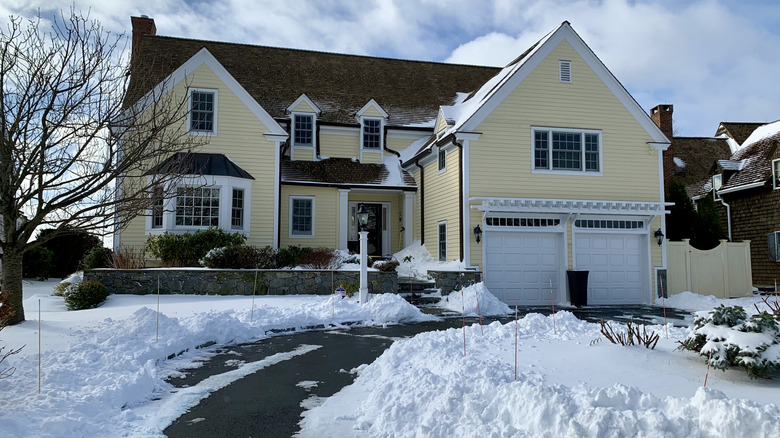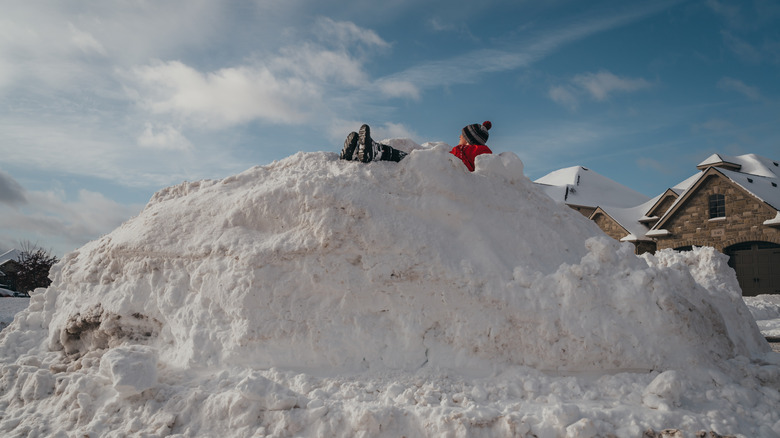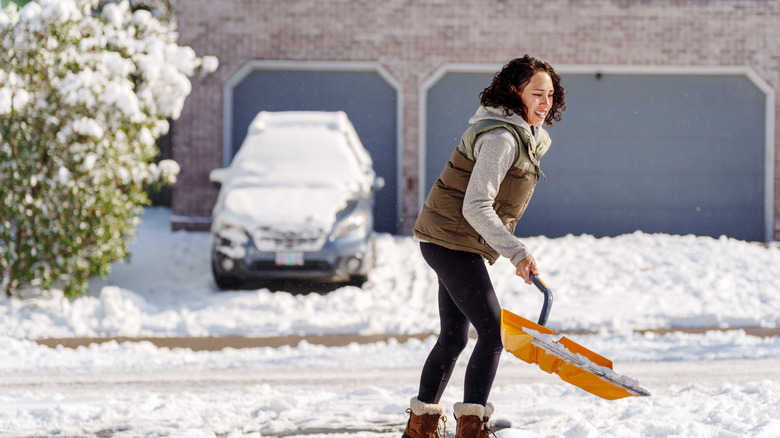Are Homeowners Responsible For Injuries Due To Not Shoveling Snow Or Ice?
With winter already in full swing, you may have seen some cold weather or have snow and ice in the upcoming forecast. While there are many handy hacks to help take care of snow and ice outside, as a homeowner, you may be wondering if it's okay to just wait for the accumulation to melt on its own. At first, this may seem like a good decision, especially if you don't plan to leave your home or have trouble shoveling your own walkway. However, if your decision to not clear the snow leads to someone's injury, are you responsible? House Digest spoke exclusively with Danny Karon, a law professor at the University of Michigan Law School and the Ohio State University Moritz College of Law, and manager of the consumer wellness website, Your Loveable Lawyer.
According to Karon, if someone falls on your driveway or walkway, whether you're liable for their injuries depends on the state's laws. In most states, especially in the Northeast and Midwest — where snow is abundant in winter — you are generally not responsible for such injuries. However, there is one caveat. "The snow and ice have to be 'natural accumulation,' Karon explained. "For example, in Ohio, the state Supreme Court ruled that property owners have no duty to eliminate natural accumulations of ice and snow from sidewalks or even to warn others, because living in Ohio in winter has inherent dangers, and slipping on ice is one of them. If laws were to hold people liable for natural phenomena like snow and ice in winter, that could become — pardon the pun — a 'slippery slope.'"
Natural vs. unnatural accumulation of snow or ice
Snow and ice accumulation can easily lead to slips and falls. This is especially common with black ice at night, when it's difficult to see hazards that may cause you to fall. But while natural accumulation that leads to injuries usually doesn't translate to liability for the homeowner, it's a different story if the build-up of snow or ice is unnatural.
According to Karon, an unnatural accumulation of snow and ice is when the homeowner purposefully or inadvertently handles these elements, after which they become hazardous. For instance, if you create a large pile of snow while shoveling, then it melts, and the water refreezes, you could end up with a large patch of ice on the sidewalk or driveway. If this patch of ice leads someone to injure themselves, you could be liable. "It could plausibly be argued that this is not a natural phenomenon, and that the homeowner instead created a hazardous condition through carelessness," Karon told House Digest exclusively.
Ways to avoid liability related to snow and ice injuries
As Karon mentioned, laws differ between states. In order to avoid facing a lawsuit wherever you live, make sure that you take the time to clean up your driveway properly. Grab your shovel or snow blower (or try this simple, but brilliant hack that'll make cleaning up snow so easy), and get to work. Also, settle on a suitable de-icing strategy — for example, decide whether to use salt or sand to melt ice on the driveway. And, if you can't shovel your snow on your own, ask a neighbor for help; likewise, offer help to someone nearby who could use the assistance. Reaching out to your neighbors can help keep the entire community safe, including people like your mail person and delivery drivers, who often walk through snow and ice for work. "The moral of the story is to do a thorough, safe job when you do shovel, and get a good [homeowner's] insurance policy," Karon said during his exclusive interview with House Digest.
Finally, civil liability for snow- or ice-related injuries is an issue that's separate from your city, town, or county snow removal bylaws and ordinances. If local regulations require you to clear off the walkway in front of your home or clean your driveway a specific way, and you fail to do so, you could still face fines or other penalties. Keeping your walkways clear of winter-related hazards helps everyone, including yourself!


